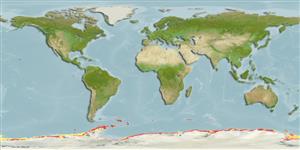Teleostei (teleosts) >
Perciformes/Notothenioidei (Icefishes) >
Nototheniidae (Cod icefishes) > Trematominae
Etymology: Trematomus: Greek, trematos = hole + Greek, tomo = section, cut (Ref. 45335); hansoni: Species name hansoni honors Nicolai Hanson, biologist of the Southern Cross Expedition.
Eponymy: Nicolai Hanson (1870–1899) was a Norwegian zoologist and Antarctic explorer. [...] (Ref. 128868), visit book page.
More on author: Boulenger.
Issue
The genus Pseudotrematomus is a synonym of Trematomus, which is confirmed by a molecular study to be published (J.-C. Hureau, pers. comm. 08 Jun. 2010).
Environment: milieu / climate zone / depth range / distribution range
Ecology
Marine; demersal; depth range 6 - 549 m (Ref. 11892). Polar; 53°S - 78°S
Southern Ocean: South Orkneys, South Georgia and South Shetland islands. Ross, Davis and Weddell seas, South Victoria, Adelie, Queen Mary and Princess Ragnhild Coasts.
Size / Weight / Age
Maturity: Lm ? range ? - ? cm
Max length : 45.5 cm TL male/unsexed; (Ref. 58849); common length : 25.0 cm TL male/unsexed; (Ref. 2121)
Adults feed on small fishes, krill and other euphausiids, polychaetes, copepods, amphipods, isopods and small gastropods. Mature individuals spawn once a year (Ref. 1071).
Dewitt, H.H., P.C. Heemstra and O. Gon, 1990. Nototheniidae. p. 279-331. In O. Gon and P.C. Heemstra (eds.) Fishes of the Southern Ocean. J.L.B. Smith Institute of Ichthyology, Grahamstown, South Africa. (Ref. 5179)
IUCN Red List Status (Ref. 130435: Version 2024-1)
Threat to humans
Harmless
Human uses
Fisheries: commercial
Tools
Special reports
Download XML
Internet sources
Estimates based on models
Preferred temperature (Ref.
123201): -1.8 - 0.5, mean -1.1 °C (based on 348 cells).
Phylogenetic diversity index (Ref.
82804): PD
50 = 0.5005 [Uniqueness, from 0.5 = low to 2.0 = high].
Bayesian length-weight: a=0.00427 (0.00274 - 0.00663), b=3.29 (3.15 - 3.43), in cm total length, based on LWR estimates for this species & Genus-body shape (Ref.
93245).
Trophic level (Ref.
69278): 3.4 ±0.54 se; based on food items.
Resilience (Ref.
120179): Medium, minimum population doubling time 1.4 - 4.4 years (K=0.22-0.23; Fec = 5,851-12,000).
Fishing Vulnerability (Ref.
59153): High vulnerability (55 of 100).
Climate Vulnerability (Ref.
125649): High vulnerability (57 of 100).
Nutrients (Ref.
124155): Calcium = 22.8 [13.3, 57.4] mg/100g; Iron = 0.459 [0.186, 0.931] mg/100g; Protein = 17.1 [16.1, 18.2] %; Omega3 = 0.352 [0.194, 0.626] g/100g; Selenium = 15.5 [6.3, 37.8] μg/100g; VitaminA = 23 [5, 116] μg/100g; Zinc = 0.487 [0.313, 0.759] mg/100g (wet weight); based on
nutrient studies.
